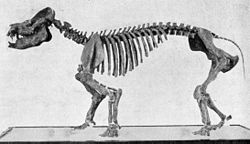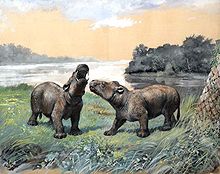- Coryphodon
-
Not to be confused with Coryphodon Constrictor.
Coryphodon
Temporal range: Late Paleocene–Early Eocene
Coryphodon hamatus skeleton Conservation status FossilScientific classification Kingdom: Animalia Phylum: Chordata Class: Mammalia Order: †Cimolesta Suborder: †Pantodonta Family: †Coryphodontidae Genus: †Coryphodon
Owen, 1845Species - C. eocaenus
- C. dabuensis
- C. lobatus
- C. oweni
- C. proterus
- C. ryani
Coryphodon (meaning peaked tooth) is an extinct genus of mammal. It was widespread in North America between 59 and 51 million years ago. It is regarded as the ancestor of the genus Hypercoryphodon of Mid Eocene Mongolia.
 Restoration by Charles R. Knight
Restoration by Charles R. Knight
 Restoration by Heinrich Harder
Restoration by Heinrich Harder
Coryphodon was a pantodont, a member of the world's first group of large browsing mammals. It migrated across what is now northern North America, replacing Barylambda, an earlier pantodont. At about 1 metre (3.3 ft) at shoulder height and 2.25 metres (7.4 ft) in body length, Coryphodon was the biggest known mammal of its time. It had a semi-aquatic lifestyle, likely living in swamps and marshes like a hippopotamus, although it was not closely related to modern hippos or any other animal known today.[1]
Fossils found on Ellesmere Island, near Greenland, show that Coryphodon once lived there in warm swamp forests of huge trees, similar to the modern cypress swamps of the American South. Though the climate of the Eocene was much warmer than today, plants and animals living north of the Arctic Circle still experienced months of complete darkness and 24-hour summer days. Chemical studies of fossil bone show that in the summer, Coryphodon ate flowers, leaves, and swamp plants. In the winter dark, they survived on pine needles, dead leaves, and fungi. This flexible diet allowed the species to spread widely across the Eocene world. [2]
Coryphodon had very strong neck muscles and short tusks that were probably used to uproot swamp plants. As in most pantodonts, the tusks were larger in males. The creature was very slow, with long upper limbs and short lower limbs, which were needed to support its weight. Coryphodon had one of the smallest brain/body ratios of any mammal, living or extinct, possessing a brain weighing just 90 grams (3.2 oz) and a body weight of around 500 kilograms (1,100 lb).[1]
References
- Prehistoric mammal stubs
- Pantodonts
- Paleocene mammals
- Eocene mammals
- Eocene extinctions
Wikimedia Foundation. 2010.
